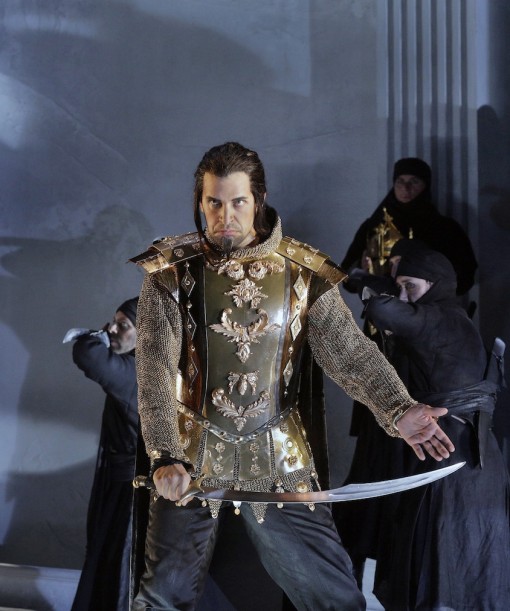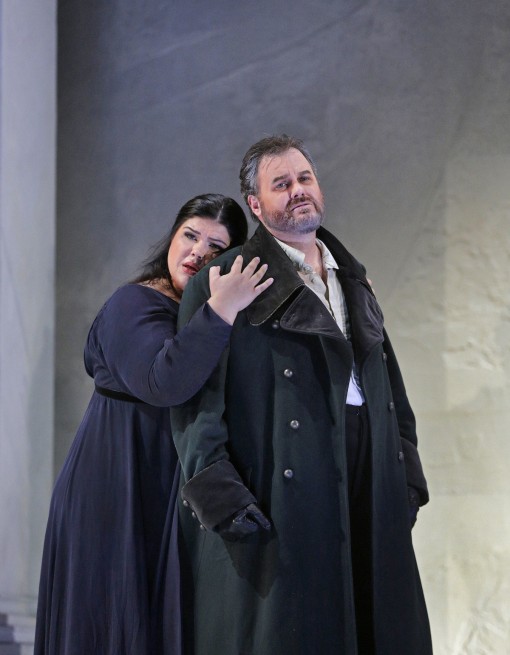Sensational singing, stormy weather and artistic courage make for a memorable Rossini revival in Santa Fe

Luca Pisaroni stars in the title role of Rossini's "Maometto II" at Santa Fe Opera. Photo: Ken Howard
Opera in Santa Fe offers unique experiences that are hard to match anywhere in the world. But even by that company’s long and distinguished history, the al fresco verisimilitude at Thursday night’s performance of Rossini’s Maometto II is unlikely to be surpassed for a long time to come.
In Act 1 of Rossini’s long-lost opera, as the chorus sings, “We’re frightened by the sounds of fighting and cannons’ thunder,” the genuine article erupted and the mountaintop, open-air venue was suddenly besieged by lightning flashes and loud, rolling thunder, making it momentarily impossible to tell the theatrical sound and lighting effects from the real thing. The meteorological obbligato continued throughout the first act, often impeccably timed to accentuate the onstage drama.
The best was yet to come. During the final tomb scene—as the women’s chorus warns of “taking flight from the approaching storm”—the temperature suddenly dropped 25 degrees and an even more violent tempest erupted with powerful winds and rain lashing across the open sides of the theater. Some audience members scurried for cover, yet the performance continued with Leah Crocetto as Anna soldiering on, performing some of the most fiendishly difficult solo bel canto music in the repertoire for over a half-hour.
Singing at all under the extreme and possibly dangerous weather conditions would have been an admirable feat but the young American soprano tackled the stratospheric fioritura, brilliant roulades and bel canto complexities fearlessly and faultlessly, in one of the most courageous acts of artistic grace under pressure one is ever like to experience.
That remarkable coda rounded off a top-flight performance of Rossini’s long-neglected curio, being presented this season in its Santa Fe debut. With a first-class cast, sensational singing and an elegant, imaginative production, Santa Fe Opera delivered a resounding performance that makes one wonder why this musically rich work has not been exhumed by more companies.
Granted, the Byzantine plot doesn’t help. The scenario concerns war between the embattled Venetians and the invading Turks in Negroponte, circa 1470. Erisso, the Venetian governor, is concerned for his daughter Anna’s safety from their enemies, and implores her to marry the young general Calbo. Yet Anna is in love with Uberto, a mysterious stranger she met while her father was away. However, Uberto turns out to be Maometto, the merciless scourage of her people whose duplicitous masquerade went awry when he fell for Anna. Complexity ensues as Maometto and Anna are conflicted with their private feelings vs. public duty against the maelstrom of the larger warring forces.
The textual history of Maometto II is even more tortuous than the scenario. The ambitious opera found little favor at its 1820 Naples premiere with audiences baffled by the unorthodox elements, such as an epic trio and an unbroken 40-minute final scene for Anna with multiple arias. Revised by Rossini, the opera found somewhat greater favor in Venice with a new happy ending replacing Anna’s suicide. Still, Rossini apparently gave up on Maometto, later substantially retooling the music to a new French libretto, as Le siège de Corinthe. The original Maometto II vanished for 150 years and in recent decades has surfaced in scattered performances. staged in cut and potted versions.
Santa Fe Opera is presenting the original 1820 version of Maometto II in the world premiere of a new critical edition prepared by Dutch scholar Hans Schellevis, and edited by Rossini specialist Phillip Gossett, to be published by Bärenreiter Verlag next year.
Even today one can understand the lukewarm reaction of the Neapolitans to the segmented 25-minute trio (truncated here) and, especially, the final tomb scene, with its unbroken forty minutes of vocal pyrotechnics for soprano. Still, despite its structural oddities and stiff narrative, there is much terrific music in Maometto II, cast in the composer’s best vein of gracious melodies and vocal bravura, including some of the most challenging music for singers Rossini ever penned.
Kudos to Santa Fe Opera for this ambitious and important historical reclamation and for pulling it off so well with a remarkable cast without a single weak link and an imaginative staging that provided an effective framework for the opera’s vocal display.
With the action updated to 1820, David Alden’s production offered a striking series of tableaux. The subdued minimalist elegance of Jon Morrell’s sets were set off by sudden theatrical effects and flashes of color like the red isosceles triangle wall that opens Act 2 or the massive sculpture of horses that rolls out for the warlike Maometto to mount. Morrell’s costumes didn’t quite cohere with the military outfits for the Venetians looking like U.S. Confederacy fatigues and the Turks garbed in contemporary ninja-style black. Duane Schuler’s dramatic lighting accented the drama with stark light and large shadows on the curved gray walls.
Luca Pisaroni was aptly commanding in the title role. For possessing such a large voice, the Italian bass-baritone was able to get around the corners of his most difficult coloratura with astounding ease and precision. Dramatically, Maometto is a thankless period stock villain, though Pisaroni brought sympathy to his moments of weakness for Anna.
Lean Crocetto’s tour de force performance as Anna was astounding, her clear, agile high soprano soaring through the most ridiculous difficulties with vocal gleam and unerring technical panache. The role is a bit of a cypher as well, with Anna merely being pained throughout much of the opera, yet Crocetto brought great fire and conviction to her confrontation with Maometto.
What tenor shortage? As in the company’s other productions this year Santa Fe Opera served up yet another terrific high-voiced singer. Bruce Sledge sang Erisso with vibrancy, a rich Italianate timbre, and thrilling top notes.
In the trousers role of Calbo, Patricia Bardon was nearly as dazzling as Crocetto, delivering the fireworks with remarkable power and assurance throughout a wide vocal range. Conductor Frederic Chaslin paced the music masterfully with rhythmic point, vigor and refinement, drawing supremely polished and dedicated playing from the orchestra.
One can’t give Santa Fe Opera too much credit for resuscitating this important opera and giving it such fizzing new life. Maometto II lives again.
There are two more performances of Maometto II, on August 7 and 16. santafeopera.org

Leah Crocetto as Anna and Bruce Sledge as Erisso in "Maometto II." Photo: Ken Howard
Posted Aug 05, 2012 at 3:44 am by Ricky
Very good review. But I do not understand how you can say that the plot is “Byzantine”. You describe it in less than 100 words and it could have been done even shorter. Compare to the plot of many other operas, even very popular ones, and it is very simple.